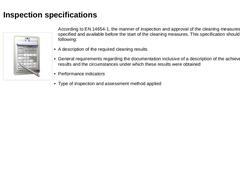
|
(Image: Picto Fakten) The manner in which the cleaning performance is to be accepted and verified should be determined before the start of the cleaning (tender document / performance specification). This should include the following points: -
Description of the required cleaning results
-
General requirements for the documentation, including a description of the cleaning results achieved and the circumstances under which the cleaning result was achieved.
|
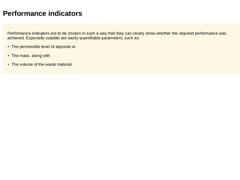
|
Important: Performance indicators should be selected so that they can be used to clearly show whether the required performance has been achieved.
Especially suitable are easily quantifiable parameters, such as: - Permissible height of remaining deposits
- Mass
- Volume of deposits removed per kilometre of sewer cleaned
EN 14654-3 recommends the following further indicators: - Percentage of the total length of sewers or drains cleaned predictively per year
…
|
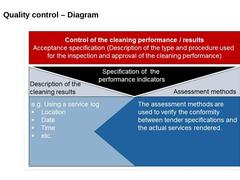
|
The diagram below shows the relationship between the performance indicators, the description of the cleaning result and the assessment methods. (Image: Quality control – Diagram) |
⚠️ |
The cleaning performance review leads to an improvement in the cleaning strategy and cleaning plan. In principle, the cleaning strategy should be regularly reviewed and updated based on information from previous cleanings. |
|
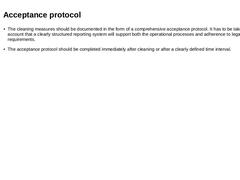
|
(Image: Picto Liste) Cleaning report The cleaning measures should be comprehensively documented in the form of a cleaning report (acceptance protocol). It should be noted that a simply structured reporting system supports the operating processes and ensures compliance with legal requirements. The cleaning report should be carried out either immediately after cleaning or after clearly defined time intervals. The following information should be included … |

|
The following techniques/methods are available as assessment methods for determining compliance between the tendered and executed services: -
Optical determination of the depth of deposits in manholes or inspection openings;
-
Direct or video-assisted optical determination of the depth of deposits in the drains or sewers (after cleaning by indirect optical inspection using a CCTV camera, drone flight or during cleaning using a cleaning nozzle with a …
|
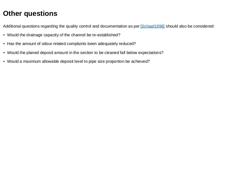
|
(Image: Frage) The following questions should already be considered with regard to quality control and documentation: -
Has the drainage capacity of the sewer been re-established?
-
Have complaints due to odour nuisance decreased to the specified extent?
-
Has the planned residual sedimentation height in the cleaned sections been undercut?
-
Was a maximum deposit height achieved as a percentage of the sewer profile height?
|
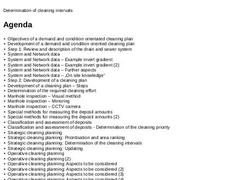
|
|
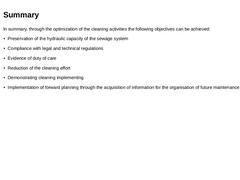
|
In summary, through the optimization of the cleaning activities the following objectives can be achieved: -
Preservation of the hydraulic capacity of the sewage system
-
Compliance with legal and technical regulations
-
Evidence of duty of care
-
Reduction of the cleaning effort
-
Demonstrating cleaning implementing
-
Implementation of forward planning through the acquisition of information for the organisation of future maintenance.
|
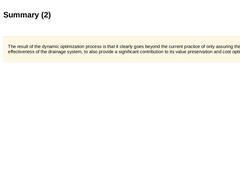
|
Important: As a result of the dynamic optimization process, it becomes clear that the task of cleaning sewer systems goes beyond the previous practice of ensuring the functionality of the drain and sewer system and makes a significant contribution to maintaining value and optimising operating costs. (Image: Cleaned, accessible sewer made of natural stone, and channel made of vitrified clay) |

|
To further optimise sewer cleaning, the chosen strategy should be evaluated retrospectively. The following indicators can be used for this purpose: -
percentage share of the total length of sewers or drains that are proactively cleaned per year;
-
percentage share of the total length of sewers or drains that are reactively cleaned per year;
-
Number of emergency cleanings per kilometre of sewer per year;
-
Number of complaints about odour nuisance, blockages, …
|
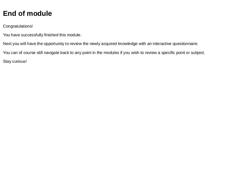
|
Congratulations! You have successfully finished this module. Next you will have the opportunity to review the newly acquired knowledge with an interactive questionnaire. You can of course still navigate back to any point in the modules if you wish to review a specific point or subject. Stay curious! |

|
|
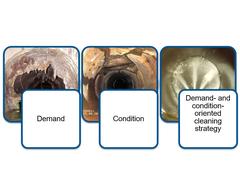
|
Operational processes in the cleaning of drains and sewers have a high ecological and economic optimization potential. Activating this potential is the overall objective of this module. After completing this module, you will have a sound knowledge of: - drawing up cleaning plans with special consideration of the structural condition of pipes and sewers and operating costs;
- possibilities for saving operating costs;
- differentiation of strategic approaches to cleaning.
|
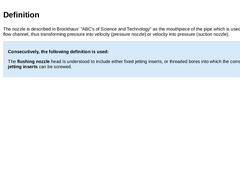
|
The nozzle is described in Brockhaus' "ABC's of Science and Technology" as the mouthpiece of the pipe which is used to narrow the flow channel, thus transforming pressure into velocity (pressure nozzle) or velocity into pressure (suction nozzle). Consecutively, the following definition is used: The flushing nozzle head is understood to include either fixed jetting inserts, or threaded bores into which the corresponding jetting inserts can be screwed. |
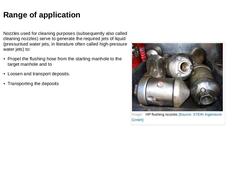
|
Nozzles used for cleaning purposes (subsequently also called cleaning nozzles) serve to generate the required jets of liquid (pressurised water jets, in literature often called high-pressure water jets) to: -
Propel the flushing hose from the starting manhole to the target manhole and to
-
Loosen and transport deposits.
-
Transporting the deposits
(Image: HP flushing nozzles) |

|
|
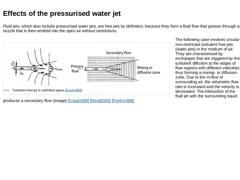
|
Fluid jets, which also include pressurised water jets, are free jets by definition, because they form a fluid flow that passes through a nozzle that is then emitted into the open air without restrictions. (Image: Turbulent free jet in unlimited space) The following case involves circular non-restricted turbulent free jets (water jets) in the medium of air. They are characterised by exchanges that are triggered by the turbulent diffusion at the edges … |
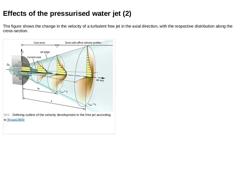
|
The figure shows the change in the velocity of a turbulent free jet in the axial direction, with the respective distribution along the cross-section. (Image: Defining outline of the velocity development in the free jet according to [Kraat1989]) |
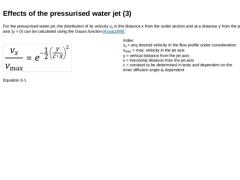
|
For the pressurised water jet, the distribution of its velocity νx in the distance x from the outlet section and at a distance y from the jet axis (y = 0) can be calculated using the Gauss function [Kraat1989]: (Formula: Geschwindigkeitsverteilung des Druckwasserstrahls (Gauß-Funktion)) Equation 3-1 Index: νx = any desired velocity in the flow profile under consideration
νmax = max. velocity in the jet axis
y = vertical distance from the jet axis
x = … |
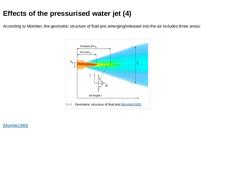
|
According to Momber, the geometric structure of fluid jets emerging/released into the air includes three areas: (Image: Geometric structure of fluid jets) [Mombe1993] |
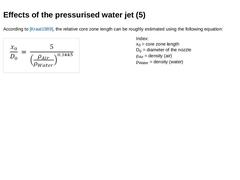
|
According to [Kraat1989], the relative core zone length can be roughly estimated using the following equation: (Formula: Equation to roughly estimate the relative core zone length) Index: x0 = core zone length
D0 = diameter of the nozzle
ρAir = density (air)
ρWater = density (water) |
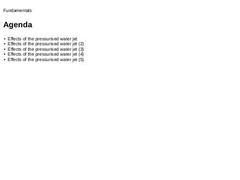
|
|
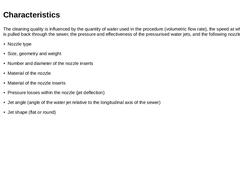
|
The cleaning quality is influenced by the quantity of water used in the procedure (volumetric flow rate), the speed at which the nozzle is pulled back through the sewer, the pressure and effectiveness of the pressurised water jets, and the following nozzle features: -
Nozzle type
-
Size, geometry and weight
-
Number and diameter of the nozzle inserts
-
Material of the nozzle
-
Material of the nozzle inserts
-
Pressure losses within the nozzle (jet deflection)
|
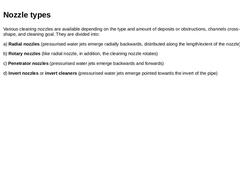
|
Various cleaning nozzles are available depending on the type and amount of deposits or obstructions, channels cross-sectional shape, and cleaning goal. They are divided into: a) Radial nozzles (pressurised water jets emerge radially backwards, distributed along the length/extent of the nozzle) b) Rotary nozzles (like radial nozzle, in addition, the cleaning nozzle rotates) c) Penetrator nozzles (pressurised water jets emerge backwards and forwards) d) |
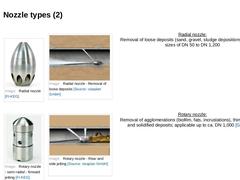
|
|
(Image: Radial nozzle) |
(Image: Radial nozzle - Removal of loose deposits) |
Radial nozzle:
Removal of loose deposits (sand, gravel, sludge depositions) in nominal sizes of DN 50 to DN 1,200 |
|
(Image: Rotary nozzle - semi radial - forward jetting) |
(Image: Rotary nozzle - Rear and side jetting) |
Rotary nozzle:
Removal of agglomerations (biofilm, fats, incrustations), thin roots, loose and solidified deposits; applicable up to ca. DN 1,000 [Geib2002] |
|